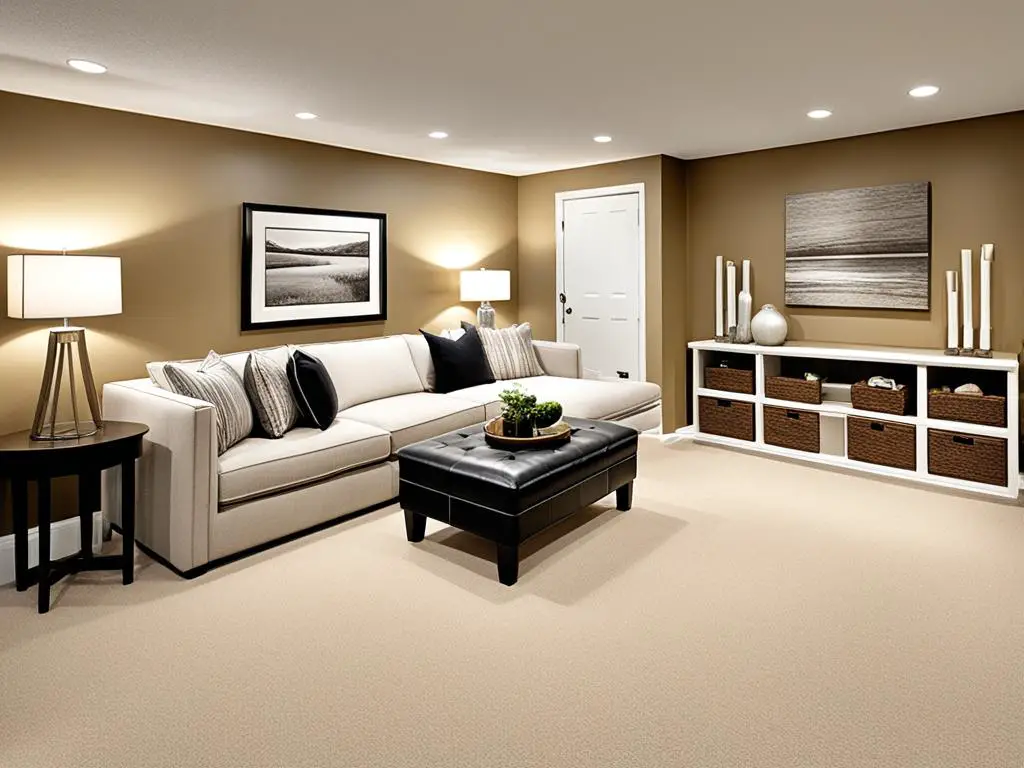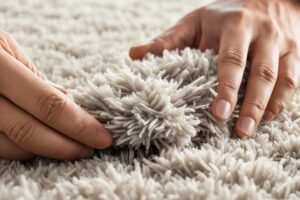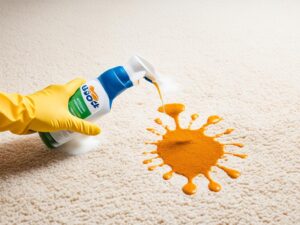Are you considering carpeting your basement but unsure about the best option? Look no further! In this article, we will explore different basement carpeting choices and help you make an informed decision.
Basements can be tricky areas to carpet, especially if they are prone to moisture. But don’t worry, there are plenty of carpeting options that can handle the unique challenges of basements.
Key Takeaways:
- Synthetic carpets are recommended for basements due to their moisture resistance and stain-resistant properties.
- Berber carpet, low-pile styles like plush carpet, carpet tiles, and sectioned carpet are all popular choices for basement carpeting.
- Consider the moisture levels in your basement before selecting a carpet fiber.
- Don’t forget to choose the right carpet padding for comfort, insulation, and moisture protection.
- Basement carpeting can provide warmth, comfort, and insulation to your space.
Synthetic Carpet for Basements
When it comes to choosing the perfect carpet for your basement, synthetic options are an excellent choice. Synthetic carpets, such as nylon, polyester, polypropylene, or triexta, offer several advantages that make them ideal for basement carpeting.
One of the key benefits of synthetic carpet is its moisture resistance. Compared to natural fibers, synthetic materials tend to retain less moisture, reducing the chances of mold growth in your basement. This is particularly important as basements are prone to dampness and humidity. By choosing a moisture resistant carpet, you can ensure a healthier environment and prevent potential mold issues.
Additionally, synthetic carpets are known for their stain resistance. Whether it’s accidental spills or everyday wear and tear, synthetic materials are designed to withstand stains and retain their original appearance for longer periods. This durability is especially important in basements where spills and accidents are more likely to occur.
To further enhance their moisture resistance, synthetic carpets often come with synthetic backing. This backing allows the carpet to breathe and expel any trapped moisture, reducing the chances of odors or damage to the underlying floor. It also helps to maintain a comfortable and dry basement environment.
Overall, synthetic carpet is a reliable and practical choice for basements. Its moisture resistance, mold-resistant properties, and stain resistance make it an excellent option for homeowners looking to create a cozy and worry-free basement space.
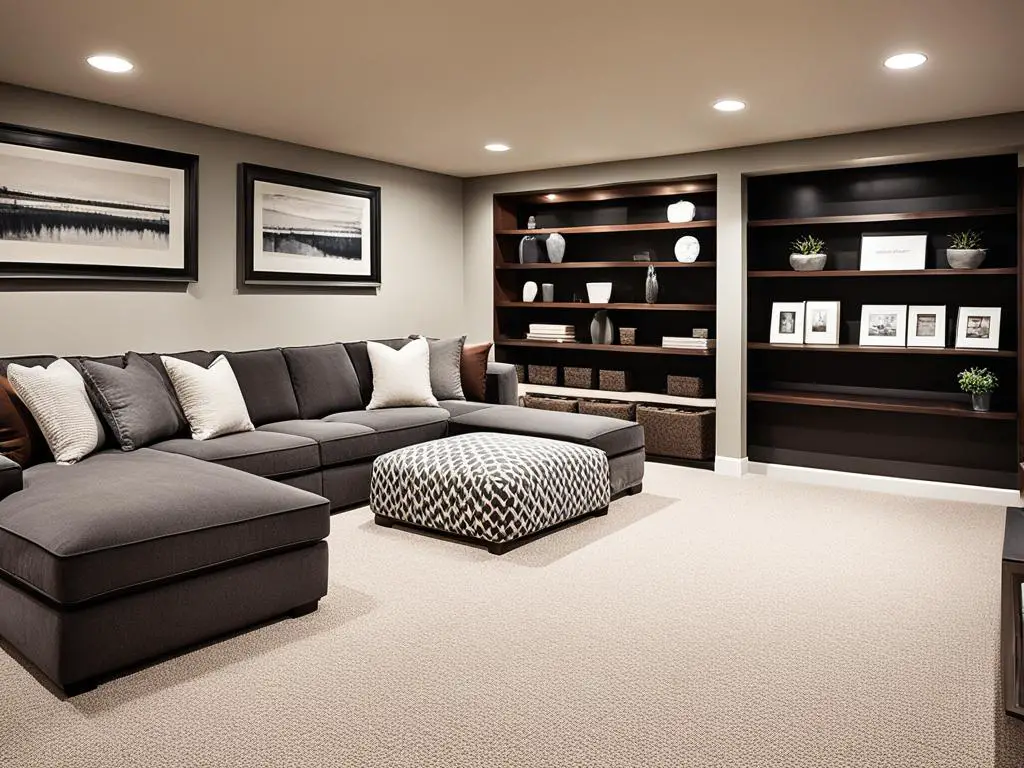
Stay tuned for the upcoming sections where we will explore other popular options for basement carpeting, such as Berber carpet, low-pile styles, carpet tiles, and sectioned carpet.
Berber Carpet for Basements
Berber carpet is a popular choice for basement carpeting due to its durability, affordability, and easy installation. It offers a practical and stylish solution for low-traffic spaces in the basement.
One of the key advantages of Berber carpet is its durability. It is made from tightly woven loops that can withstand heavy foot traffic without showing signs of wear and tear. This makes it an ideal choice for basements that are used less frequently or have minimal foot traffic.
In addition to its durability, Berber carpet is also known for its affordability. It is often more cost-effective compared to other types of carpet, making it a budget-friendly option for basement renovations or finishing projects.
Furthermore, Berber carpet is easy to install, especially when combined with a suitable carpet pad. Its low pile height and tight weave make it a relatively straightforward choice for DIY enthusiasts or homeowners looking for a quick and hassle-free installation process.
When choosing Berber carpet for basements, it is important to consider the fiber type. Nylon is a common material used in Berber carpets and offers excellent stain resistance, making it suitable for high-traffic areas. On the other hand, polypropylene is also used in Berber carpet construction but is better suited for low-traffic spaces due to its lower stain resistance.
To illustrate the advantages of Berber carpet for basements, consider the following features:
- Durability: Tightly woven loops withstand heavy foot traffic and daily wear.
- Affordability: Budget-friendly option for basement renovations or finishing projects.
- Easy Installation: Low pile height and tight weave make it a straightforward choice.
- Fiber Types: Nylon for high-traffic areas, polypropylene for low-traffic spaces.
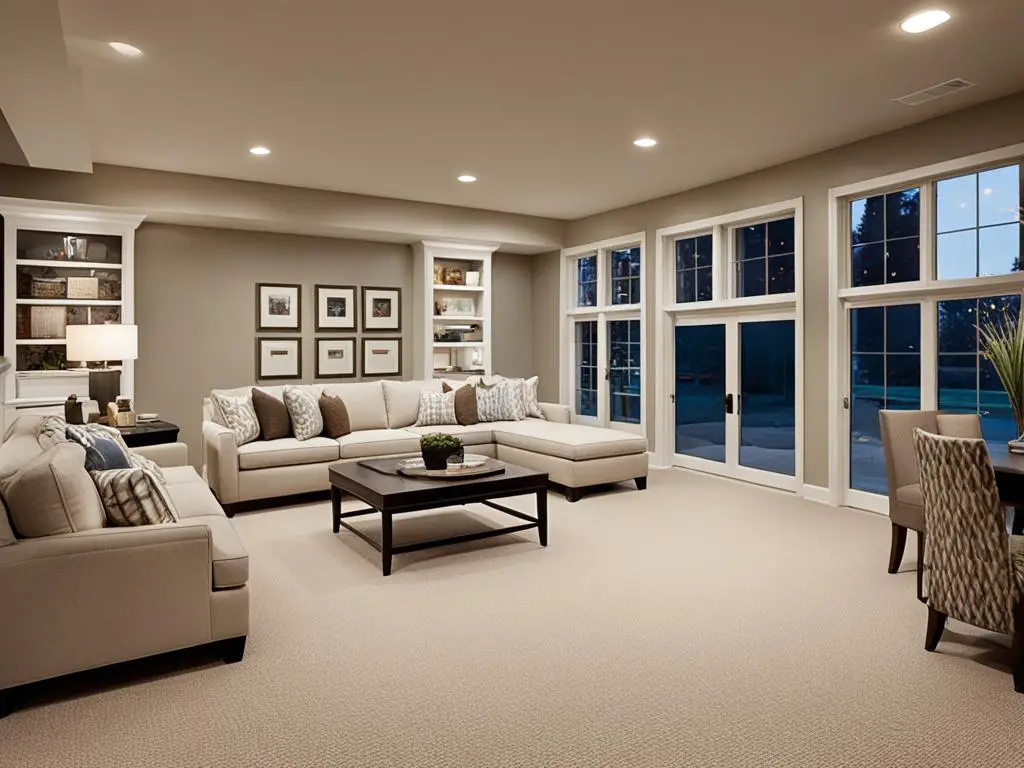
Overall, Berber carpet is a durable, affordable, and easy-to-install option for basement carpeting, particularly in low-traffic spaces. Its ability to withstand wear and tear, combined with its budget-friendly price point, makes it an attractive choice for homeowners looking to enhance their basement’s comfort and appearance.
Low-Pile Basement Carpet
When it comes to choosing carpet for your basement, low-pile options like plush carpet are a fantastic choice. These carpets offer several advantages that make them ideal for basements with moisture concerns and heavy foot traffic.
One of the key benefits of low-pile carpet is its quick-drying properties when exposed to moisture. Whether it’s a spilled drink or a small water leak, low-pile carpets dry faster, reducing the chance of mold and mildew growth. This moisture resistance is particularly important for basements, where dampness and humidity can be an issue.
Another advantage of low-pile carpets is their ease of cleaning and maintenance. With their short and dense fibers, they are less likely to trap dirt, dust, and debris. Regular vacuuming and occasional spot cleaning are usually all that’s needed to keep these carpets looking clean and fresh. This makes them highly practical for households with pets, children, and busy lifestyles.
In terms of durability, low-pile carpets hold up well under heavy foot traffic, making them suitable for both residential and commercial basements. Their dense fibers help minimize wear and tear, ensuring that the carpet maintains its appearance and functionality for years to come.
To get the most out of your low-pile basement carpet, opt for a synthetic carpet with short fibers. Synthetic materials like nylon or polyester offer excellent moisture resistance and durability. These carpets are also available in a wide range of styles, colors, and patterns, allowing you to find the perfect match for your basement’s aesthetics.
Low-pile carpets are a practical and stylish choice for basements, offering quick-drying properties, easy maintenance, and durability. Their moisture resistance and stain-resistant properties make them a great option for homes with moisture concerns, while their dense fibers make them suitable for heavy foot traffic areas. Choose a synthetic low-pile carpet to enjoy the benefits of both functionality and aesthetic appeal.
Low-Pile Basement Carpet Maintenance Tips:
- Vacuum regularly to remove dirt, dust, and debris.
- Address spills and stains promptly to prevent them from setting into the carpet fibers.
- Consider using carpet protectors under furniture legs to prevent indentations.
- Use doormats or rugs in high-traffic areas to minimize wear and tear.
- Periodically deep clean the carpet to remove embedded dirt and rejuvenate its appearance.
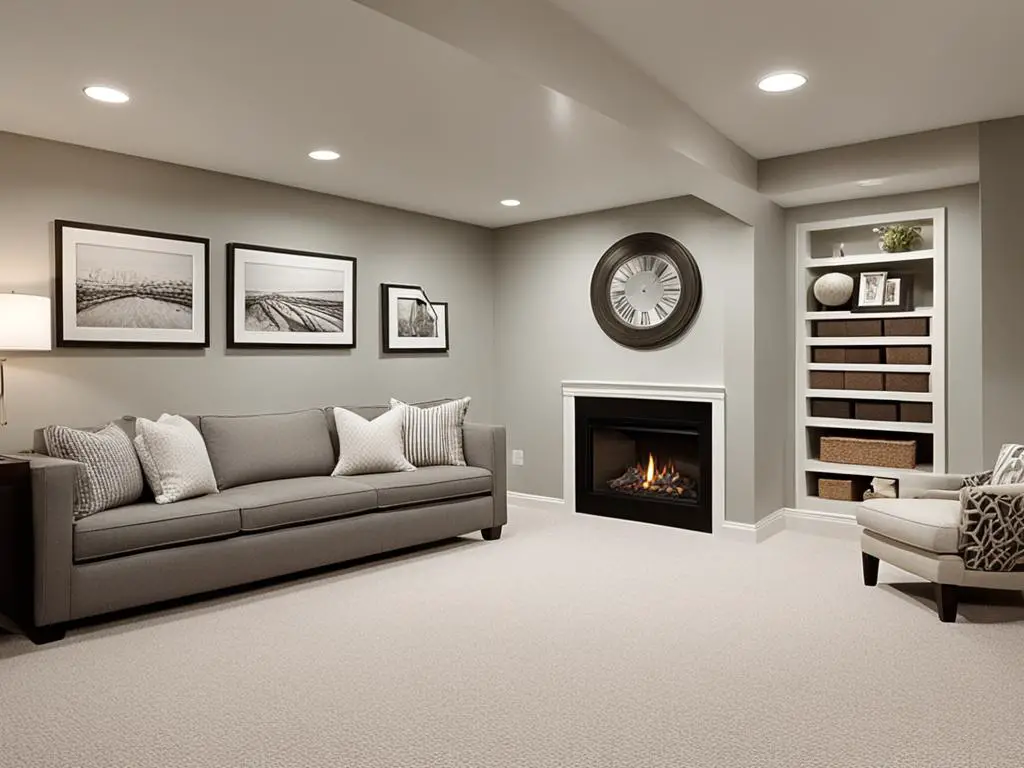
Carpet Tiles
Carpet tiles provide a versatile and practical solution for basement flooring. With their easy replaceability and endless design possibilities, they have become a popular choice among homeowners.
One of the key advantages of carpet tiles is their ease of replacement. In the event of damage or staining, you can simply remove the affected tile and replace it with a new one, rather than replacing the entire carpet. This makes carpet tiles a cost-effective option, as you only need to replace the damaged portion.
Design possibilities are another major benefit of carpet tiles. They come in a wide range of designs, including monochrome, stripes, geometric patterns, and checks. This allows you to create unique and stylish looks in your basement, tailored to your personal taste and decor.
Installation is also a breeze with carpet tiles. Unlike traditional carpet rolls, which can be bulky and difficult to maneuver, carpet tiles are lightweight and easy to handle. They can be installed individually, allowing for easy customization and the ability to create intricate patterns if desired.
Furthermore, carpet tiles offer additional design possibilities beyond simple floor coverings. They can be used to create area rugs, room dividers, or even wall-to-wall carpeting. With their modular nature, you can mix and match colors and patterns to create a truly customized look.
Overall, carpet tiles are a fantastic choice for basement carpeting, combining easy replaceability, design versatility, and hassle-free installation. Consider the endless design possibilities and practicality they offer when choosing the perfect flooring option for your basement.
Sectioned Carpet
In moisture-prone basements, choosing the right flooring option is essential. Sectioned carpet provides a cost-effective solution that allows you to carpet only a portion of the basement, saving you money compared to wall-to-wall carpeting. This approach is particularly beneficial for smaller basements or areas with localized moisture issues.
Sectioned carpet involves using carpet remnants, which are often available at a lower cost than full rolls of carpet. These remnants can be used to cover single rooms or open floor plans, providing a practical and budget-friendly carpeting option for basements.
By focusing on specific sections of the basement, you can allocate resources efficiently and target areas that are most prone to moisture. This approach not only saves money but also minimizes the risk of potential water damage to the carpet.
When using sectioned carpet, it’s important to properly measure and plan the installation process to ensure a seamless transition between sections. This may involve using transition strips or other methods to create a cohesive and visually pleasing carpeted space.
Benefits of Sectioned Carpet for Moisture-Prone Basements
- Cost-effective option compared to wall-to-wall carpeting
- Allows for targeted carpeting in areas with localized moisture issues
- Utilizes carpet remnants, which are often available at a lower cost
- Provides flexibility for covering single rooms or open floor plans in smaller basements
- Minimizes the risk of potential water damage to the carpet
To illustrate the cost-effectiveness of sectioned carpet, consider the following example:
| Basement Area | Price per Square Foot (Wall-to-Wall Carpeting) | Price per Square Foot (Sectioned Carpet) |
|---|---|---|
| 500 square feet | $5 | $3 (including installation and transition strips) |
| 1,000 square feet | $5 | $4 (including installation and transition strips) |
| 2,000 square feet | $5 | $4.50 (including installation and transition strips) |
As seen in the table above, sectioned carpet can result in significant cost savings, especially for larger basement areas.
Choosing the Right Carpet for Basements
When it comes to basement carpeting, it’s crucial to account for the moisture levels underground. Synthetic carpets are recommended for their breathability and excellent moisture resistance, making them an ideal choice for basements. On the other hand, natural fiber carpets like wool can absorb excessive water, leading to increased humidity and potential mold growth.
When selecting a synthetic carpet, consider the basement’s purpose and expected foot traffic. Different fibers, such as nylon, polyester, or triexta, offer varying levels of durability and stain resistance. Nylon is known for its exceptional resilience and ability to withstand heavy use, making it suitable for high-traffic areas. Polyester offers excellent color options and is a softer, more luxurious choice. Triexta, a relatively new synthetic fiber, combines both durability and stain resistance.
To enhance comfort, insulation, and moisture protection in basements, using carpet padding is essential. Opt for polyurethane foam padding, which not only adds cushioning but also contributes to moisture management.
Benefits of Synthetic Carpets for Basements:
- Moisture resistant
- Breathable to prevent mold and mildew
- Durable and stain resistant
- Wide range of styles and colors
In basements, where moisture can be a concern, synthetic carpets provide the necessary moisture resistance, preventing mold and mildew growth while maintaining durability and aesthetic appeal.
Choosing the right carpet for basements involves considering the moisture levels, selecting synthetic fibers suitable for the basement’s purpose and foot traffic, and ensuring proper carpet padding. With these considerations in mind, you can enjoy a comfortable and moisture-resistant carpet in your basement.
Conclusion
In conclusion, when it comes to basement carpeting, choosing the right carpet is crucial for creating a comfortable and moisture-resistant space. Synthetic carpets, such as nylon, polyester, polypropylene, or triexta, are the best options due to their excellent moisture resistance and stain-resistant properties. These carpets are designed to withstand the challenges that basements can present, ensuring durability and longevity.
Among the various types of synthetic carpets, Berber carpet stands out for its durability and affordability. Its tight loop construction and stain-resistant fibers make it an ideal choice for both high and low-traffic areas. For those looking for a carpet that dries quickly and is easy to clean, low-pile styles like plush carpet are the way to go. Their short, dense fibers offer excellent moisture resistance and are perfect for homes with pets and children.
Carpet tiles and sectioned carpet are also popular options for basements. Carpet tiles provide versatility and ease of replacement, allowing you to mix and match designs for a unique look. On the other hand, sectioned carpet offers a cost-effective solution for moisture-prone basements, covering only specific areas without the need for wall-to-wall installation.
Prior to installing basement carpeting, it is essential to address any moisture issues present. This ensures a dry and stable environment for the carpet, reducing the risk of mold and mildew growth. Additionally, selecting the appropriate carpet fiber and padding based on the basement’s needs is crucial for long-lasting performance. With the right choices, basement carpeting can provide warmth, comfort, and insulation to transform your basement into a cozy and inviting space.
